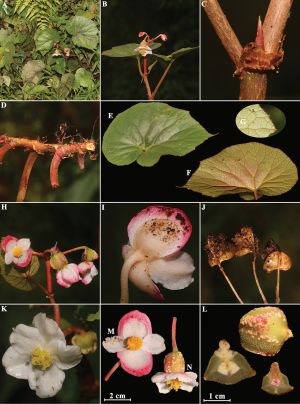Begonia crassitepala
Species Information
Classification and Distribution
Begonia crassitepala, a perennial monoecious rhizomatous herb, is morphologically similar to Begonia dryadis but distinguished by its stem and petiole with white prickles, adaxially leaf with densely pinkish or grey hirsute, and other distinct features. It is endemic to Putao District, Kachin State, Northern Myanmar.
Habitat
This species grows in a tropical montane forest at elevations of approximately 577 meters, on moist soil slopes.
Characteristics
Begonia crassitepala has an erect stem, 40–60 cm tall, reddish, densely rusty wooly tomentose with sparse whitish soft spine-like hairs. The leaves are ovate to broadly ovate, asymmetric, with a green adaxial surface that is densely pinkish or grey hirsute, and an abaxial surface that is green and rusty puberulous.
Flower Details
The species has staminate flowers with 4 unequal tepals, numerous stamens, and pistillate flowers with 5 equal obovate tepals. The ovary is 2-locular, with placentation axillary and styles 2, fused at base.
Etymology
The species epithet 'crassitepala' refers to its thick tepals.
Comparison to Similar Species
Begonia crassitepala can be distinguished from Begonia dryadis by features such as stem and petiole with white prickles, adaxially leaf with densely pinkish or grey hirsute, and abaxially outer 2 tepals of pistillate flower with reddish or whitish succulent strigose.
